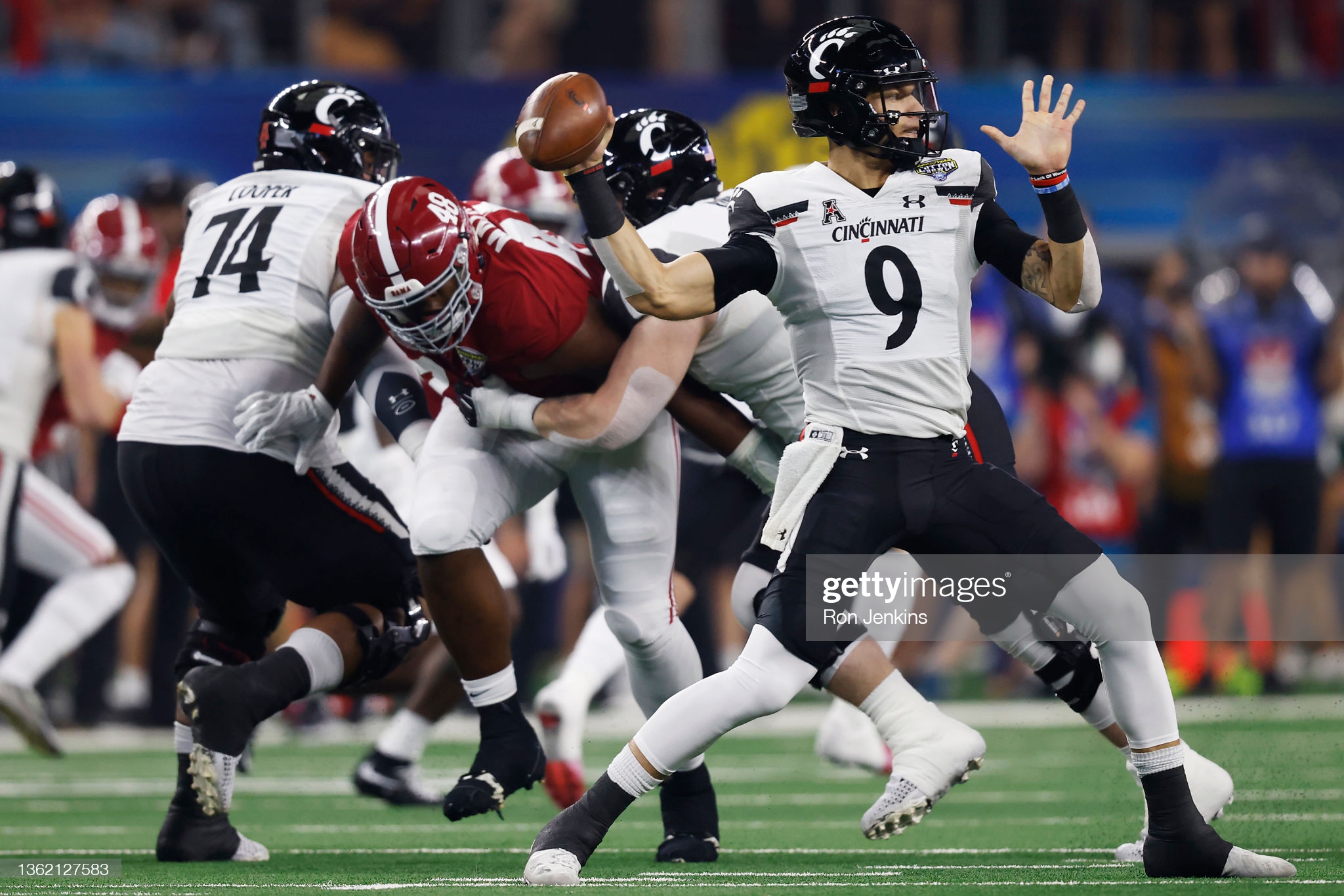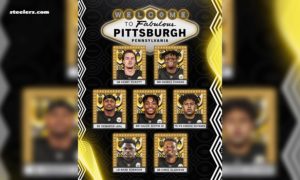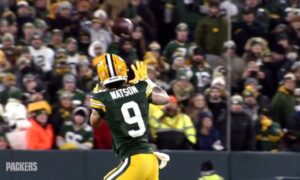From now until the 2022 NFL Draft takes place, we hope to scout and create profiles for as many prospects as possible, examining their strengths, weaknesses, and what they can bring to an NFL franchise. These players could be potential top 10 picks, all the way down to Day 3 selections and priority undrafted free agents. Today, I’ll be profiling a prospect that has been a four-year starter and brings a unique blend of mobility and arm talent to the table as a potential franchise quarterback.
#9 Desmond Ridder, QB, Cincinnati (Senior) – 6033, 211 lbs.
Measurements
Senior Bowl/Combine Invitee:
| Player | Ht/Wt | Hand Size | Arm Length | Wingspan |
|---|---|---|---|---|
| Desmond Ridder | 6033/211 | 10 | 32 3/4 | 79 |
| 40-Yard Dash | 10-Yard Dash | Short Shuttle | 3-Cone | |
| 4.52 | N/A | 4.29 | 7.15 | |
| Broad Jump | Vertical | Bench Press | ||
| 10’7″ | 36 | N/A |
The Good
— Has the height and long frame you want in a QB prospect
— Impressive athleticism in terms of mobility and speed
— Has 28 career rushing TDs, most ever for a UC QB
— Often utilized on zone read/RPO runs with the option to give or keep it based on the defense
— Has good ball carrier vision and is fairly elusive as a runner in the open field
— Is a long strider that has good build up speed
— Moves fairly well within the pocket to evade pressure coming at him
— Has a powerful arm that can launch the football well over 50+ yards down the field
— Can throw the ball on a rope to the sideline on a tight spiral
— Can place the ball well over the middle of the field well with touch on his throws
— Has moments where he fits the ball into tight windows over the middle of the field or dropping into this receiver’s hands over a defender
— Very competent at making throws off-platform while on the run
— Can work outside of the pocket and extending the play for his receiver to come open downfield
— Does a good job keeping his eyes down the field when pressure is in his face
— High-character kid with the leadership qualities and desire to get better you want to have in your signal caller
— Has a career record of 44-5 as a starting QB, established winner in college
The Bad
— Doesn’t have the bulk as a runner to break through tackles and get out of the sack
— Isn’t a sudden, dynamic athlete with elite long speed and burst as a runner
— Will run to the sideline to avoid getting hit instead of going through contact or sliding to pick up extra yardage
— Deep ball placement/accuracy needs to improve and be more consistent
— Has a tendency to sail balls high over receivers when pressure gets to him
— Will have to improve his ability to go through his reads and take what the coverage is giving him rather than try and force the issue
— Footwork in the pocket needs to clean up as he tends to stand tall often and will slip when lacking a solid base
— Needs to have better ball security in the pocket when taking pressure or getting hit
— Can do better at sensing pressure coming at him and throwing the ball away to avoid taking so many hits
— Dealt with a shoulder injury in the 2019 campaign
Bio
— Senior prospect from Louisville, KY
— Labeled a three-star prospect by most recruiting agencies as a dual-threat QB
— Redshirted his first season on campus in 2017
— Burst onto the scene in 2018, starting 11 games and completing 194-of-311 attempts (62.4%) for 2,445 yards and 20 TDs to five INTs while adding another 583 yards rushing along with five more scores on 149 carries
— Started all 13 games played as a sophomore, completing 179-of-325 passes (55.1%) for 2164 yards and 18 scores to nine INTs, adding in another 650 yards and five TDs on the ground
— Helped lead the Bearcats to an AAC Championship and the team’s first New Year’s Six appearance since 2009 as a junior, completing 186-of-281 passes (66.2%) for 2296 yards and 19 TD to six INTs, adding in 98 carries for 592 yards and 12 scores on the ground in ten starts
— Played in 14 games as a senior, completing 251-of-387 passes (64.9%) for 3,334 yards and 30 TDs and eights INTs while adding 110 carries for 355 yards and six TDs on the ground
— 2020 and 2021 AAC Offensive Player of the Year, 2018 AAC Rookie of the Year
— 2019 AAC All-Academic Team, earned his bachelor’s degree on Dec. 12, 2020
Tape Breakdown
Desmond Ridder of Cincinnati is one of the many intriguing names of QBs that will be in the mix to hear their name called early draft day come April. Ridder wasn’t a highly touted recruit coming out of Kentucky but has made the most of his time with the Bearcats, showing improvement both on and off the football field in his time on campus. One of my fellow former co-workers at the University of Florida has been on the coaching staff for the Bearcats the last couple of seasons, working with Ridder daily and has had an opportunity to help him develop as an athlete and football player. When asked about Ridder’s character and work ethic, this is what he had to say:
“Desmond has great leadership skills, he’s not afraid to hold everyone to the standard that the coaches set. He’s a kid that loves the process and loves to train. No matter what we do he likes to compete, it can be smallest thing he still wants to win and be the best.”
Hearing this come from one of the members of the coaching staff can be expected when addressing their starting QB, but I fully believe it based on the success the Cincinnati program has had the last several years with Ridder at the helm and how emotional he was when they won the AAC Championship Game in back-to-back seasons, boasting a 44-5 career record and leading non-Power-5 Cincinnati to the CFP in 2021.
Ridder the football player combines superb athleticism at the QB position along with stellar arm talent to be an enticing prospect to a lot of NFL teams. As a runner specifically, Ridder is a long strider that eats ground quickly when he decides to tuck the ball and use his legs. He doesn’t possess freaky burst or elite speed, but he still is a threat to break a long one should he see open grass. For example, on this play against Houston, Ridder gets pressured inside the pocket and escapes up the middle, covering ground quickly as he runs his way to the end zone, angling toward the pylon as he waves through traffic and gets to pay dirt for six.
He is more than capable of running the zone read/RPO system that has become so popular over the last several years in the league, making the defense have to commit defenders to him at the handoff to either take pressure off of the back or make the defense pay by keeping it and picking up yardage himself on the ground like on this play against Notre Dame where Ridder keeps the ball and scoots into the end zone on the read option.
Ridder isn’t the most dynamic dual-threat QB out there, but he has good vision in the open field and can be elusive enough to make defenders miss in space. Take this run against SMU for example has he tucks and runs up the middle on the QB draw, hitting the stiff arm and leaping out of the diving tackle attempt as he accelerates to the sideline, getting the corner on the defensive back in pursuit for the score.
While he doesn’t possess a rare second gear as a runner, Ridder’s long strides do help him outrun his opponents in the open field when he sees daylight. In the same game against SMU, we see Ridder fake the give on the zone read and run to the left, getting a key block from his TE near the sideline that springs him into the open field. Sure, he doesn’t really pull away from the field, but his long strides do enough to keep the defense catching him from behind on the long touchdown run.
His mobility also is a great asset when flushed out of the pocket to extend the play and allow for his receivers to break open downfield against coverage. Here against Georgia, we see Ridder get pressure coming to his side, forcing him to the right. However, he does a great job keeping his eyes downfield as a passer squares up his feet and throws across the field while getting sandwiched in-between two defenders to his man coming back from the corner of the end zone on the diving catch attempt for the score.
Here’s another example of Ridder throwing on-the-run against Alabama in the CFP, getting pushed out of the pocket by pressure coming his way but escapes to the right sideline and throws a pretty ball along the sideline to his receiver. The receiver is unable to maintain possession of the catch, but this play highlights a great throw by Ridder that was on-target while on the move.
In terms of arm strength, Ridder is not lacking in this area as he has the throw power to sling it deep down the field. He has a smooth release and can place a lot of arc on his passes to give his guy a chance to either run underneath the ball in the air or climb the ladder and go get it against contested coverage. Check out this deep heave against UCLA back in 2019 where Ridder is able to step up in the pocket and deliver this bomb nearly 60 yards in the air to his man in single coverage, placing high for his man to go up and win the contested catch and come down with the ball inside the red zone.
Along with the arm strength, Ridder possesses impressive touch on his passes down the field, being able to zip in in there on a dart over 40 yards away like we see on this TD pass against ECU where he hums it in on a line to his receiver on the right sideline who edges out the defender in coverage for the walk-in score from midfield.
His play action passes can be extremely difficult to defend given the threat of the running back taking the hand off or his ability to simply tuck and run the ball should he see green grass. This forces defenses to play him honest, resulting in a good amount of single-man coverage looks. Here against ECU we see him execute the play action well and step up to deliver a strike down the field, looking like a laser to his man from 35 yards away.
While he has the arm strength, Ridder throws the ball with a fair amount of touch as well, recognizing when he needs to put more on his throws or take some off. Check out this pass down the right sideline against the Crimson Tide where Ridder drops the ball into the bucket over the defender into the end zone. The receiver again fails to survive the ground as the ball comes out, but this pass can’t be thrown any better by Ridder.
While Ridder has some impressive qualities as a passer, he still needs to prove he can be more consistent in terms of his accuracy and decision making. Ridder took notable strides forward this season in this area in terms of mechanics, but there still as a few key areas he needs to get better to play at the NFL level. For example, Ridder tends to sail passes high over his intended target when he senses pressure getting to him in the pocket like we see on this misfire on the crosser over the middle against Alabama.
Another example of Ridder airmailing a pass to his intended target against the Fighting Irish as the receiver has a step of separation on the defender, but Ridder senses pressure coming around the corner and misses high.
Not only will Ridder sail passes overhead receivers at times, but he also can tend to short arm passes and throw into the turf when pressure sets in. Here an example against the Cougars where Ridder feels pressure coming from the backside and seemingly short arms his pass to the right sideline, not getting enough power on his throw and thus places it short and inside for the defender in coverage to run underneath for the interception.
While his ball placement can be impressive at times, his overall consistency has to improve at all levels of the field. Ridder needs to do a better job of making his reads through his progressions and deliver an accurate ball on time to his man in tight windows. Case in-point here on this pass over the middle against Houston where he has a receiver breaking open over the middle of the field, but places the ball behind his intended target, making it easily defensible by the defender in coverage to knock down the pass.
Conclusion
Overall, there is a lot to like from the physical perspective of Ridder’s game. He has the mobility inside and outside of the pocket, the dual-threat capability with his legs, and the arm talent to challenge defenses from a variety of different facets of the game. He also has a good head on his shoulders from a character standpoint and has shown a willingness and dedication to improve as a passer from when he first arrived on campus.
However, he will need some refinement from a passing standpoint to be more consistent with his accuracy and ball placement on his deep throws. Ridder also needs to be able to sense pressure better in the pocket and be able to protect the football better when he is going to get hit or be willing to throw it away and not force an arid pass where it shouldn’t go.
Initially I wanted to compare Ridder to Colin Kaepernick coming out of Nevada, but watching recent draftee Trey Lance next to Ridder, there are a lot of similarities between the two. Both are from smaller schools and played mostly questionable competition but managed to dominate with the arm talent and ability to gash defenses on the ground with their legs. Both excel in run-first offensive systems but are fairly raw as passers that can struggle with deep ball accuracy and consistently going through their progressions. Sure, Lance has about 10lb on Ridder and is a more physical runner, but both have similar frames, play styles, and upsides in terms of dual-threat QBs with impressive arm talent that needs some seasoning.
Given what I have seen thus far and his projection to the NFL, I would like to see Ridder get drafted to a team with an incumbent starter in-place where he can sit the first half, if not the full season, to learn the system and develop instead of being thrown to the fire. He will be a good fit for a West Coast offensive system that wants to execute read option and RPOs with their passer but has the potential to develop into a capable pocket passer as well. He needs development, but in today’s league and with the skills and mindset he has, I do think he can become an NFL starter.
Projection: Late Day One / Early Day Two
Depot Draft Grade: 8.5 – Future Quality Starter (2nd Round)
Games Watched: vs. Georgia (2020), at SMU (2020), vs. Houston (2020), vs. Alabama (2021), at Notre Dame (2021)








